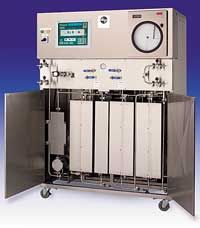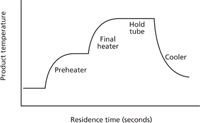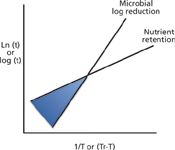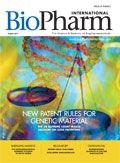Applying Continuous-Flow Pasteurization and Sterilization Processes
The author discusses HTST pasteurization and UHT sterilization.

Photo courtesy of MicroThermics, Inc. High-temperature, short-time (HTST) pasteurization and ultra-high temperature (UHT) sterilization are continuous-flow thermal processes that have been established and highly refined in other industries for many years. Their precision and minimal impact enable the manufacture of products that cannot be made using batch technologies. HTST and UHT are traditionally used for heat-sensitive products. As continuous-flow processes, they are effective against vegetative cells, viruses, and heat-stable endospores. These characteristics and their continuous-flow nature make them potentially useful as part of the trend toward methods of continuous manufacturing of bio/pharmaceuticals.
Technologies frequently evolve separately, often independently, in unrelated industries and transfer between them. This transfer is often how industries and technologies advance and take significant steps forward. Identifying a technology that is proven, highly refined, and fully supported industrially and regulatorily, however, is less common. This is the case for high-temperature, short-time (HTST) pasteurization and ultra-high temperature (UHT) sterilization. HTST and UHT are continuous flow, thermal processes that have been used to pasteurize and sterilize liquids (e.g., foods) for more than 60 years. The processes have been developed as tightly controlled systems and refined to reliably produce high quality products at low cost. HTST and UHT have been optimized to reach high assurance levels for inactivation of vegetative cells, viruses, and heat-stable endospores, all while retaining quality that could not be maintained using batch processes, such as autoclaving.
HTST and UHT in the Food Industry
It seems somehow concerning to use a process that has evolved for food products, such as milk and juices, and use it for highly refined pharmaceuticals, but let's consider the fundamentals. The chemical-reaction kinetics that describe how and why these processes inactivate bacteria but retain the quality in a biological fluid (e.g., milk) are the same as in any other biological fluid. Commercially, these processes are well established and used for products ranging from juices to baby food and even products as sensitive as liquid whole egg. These processes have annual capacities measured in hundreds of billions of packages per year. Commercial equipment for HTST and UHT processes commonly operate at flow rates ranging from roughly 5 gallons to more than 100 gallons per minute. Commercial capacities, however, do not lend themselves to the batch sizes and rapid cycles of research and development. The need to conduct thorough research and to optimize treatments (e.g., hold time, temperature, and heat transfer) for different products has triggered the development of miniaturized research equipment and experimental methods for this purpose. These tools have enabled R&D professionals to address potential manufacturing issues early and avoid losses and costly problems while also helping these processes to become better understood. Optimization of these processes has led to development of a wide assortment of time and temperature treatments as well as highly refined tools to test products and deliver these treatments. As a consequence, small-capacity systems have been developed for lower flow rates, bringing the benefits of HTST pasteurization and UHT sterilization to the high-value, low-volume materials of pharmaceuticals.
Sterliization Continuous Manufacturing
Continuous manufacturing has been described as a manufacturing breakthrough and as the method of the future by Konstatine Konstantinov, vice-president of commercial process development at Genzyme (now part of Sanofi), and Robert Bradway, chairman and CEO of Amgen (1, 2). The trend toward using this method is increasing as manufacturers of bio/pharmaceuticals strive to meet growing demand, reduce floor space, improve manufacturing flexibility and capacity, and reduce costs.
The adoption of continuous manufacturing for biopharmaceuticals emphasizes the need to inactivate microorganisms continuously at rates consistent with these new processes. The adoption of HTST and UHT continuous processing and surrounding technologies is a natural fit. Early adopters in the biotechnology and biopharmaceutical industries have begun to deploy these processes. The question remains, however, what are the reasons to adopt HTST and UHT in these industries? Are their benefits simply a function of the continuous process or are there additional benefits that make HTST and UHT even more desirable?
Benefits ofF HTST and UHT
The benefits of HTST and UHT processes result from their continuous flow nature and their use of different and more highly refined time and temperature conditions. To understand their benefits, it is useful to consider an example process like that shown in Figure 1. The product is pumped continuously through the process at constant flow and is heated to the process temperature under steady-state conditions. It flows through the hold tube, which is of sufficient length to ensure that the product is hot for the time needed for the required lethality, before it is cooled as it exits the system. The result is that the product experiences a controlled, well-defined time–temperature exposure. This time–temperature history (TTH), conceptually shown in Figure 2, is usually less than two minutes from start to finish. Although there are relatively few rules linking the terms "pasteurization" or "sterilization" to specific temperatures, for the sake of this discussion, pasteurization is usually conducted at hold-tube temperatures between 70 °C and 121 °C. Sterilization hold temperatures range from 128 °C to 150 °C. Hold times most commonly range from 2 to 30 seconds.

Figure 1: Flow diagram for continuous-flow thermal processes. (ALL FIGURES COURTESY OF AUTHOR)
Because HTST and UHT continuous-flow processes are closed systems that operate at steady state, the impact of the thermal process on product quality and lethality is uniform and independent of batch and container size. In contrast, the thermal exposures delivered to liquids being pasteurized or sterilized in large-scale fermenters or vessels in autoclaves/retort are not as uniform because the heat exposure varies with the container size and location. In comparison, it becomes apparent that, in the continuous process, several major sources of variation and potential points of failure have been eliminated and overprocessing has been greatly reduced.

Figure 2: Conceptual plot of product timeâtemperature history.
As thermal processes, HTST and UHT processes are effective against viral contamination. These processes are especially useful for emulsions and suspensions that are not compatible with filtration. They provide real-time monitoring and record-keeping of processing conditions. They are precise, and the actual process time and temperature conditions can be adjusted to optimize the retention of key components and the delivered lethality. This precision can be important to maximize retention of key media components being fed into a fermentation process or of a desired active agent resulting from a different step of manufacture.
Unlike scale-up of batch operations, scale-up of HTST and UHT processes is often unnecessary because processing more material is linked only to the processing time, not the vessel size. Larger volumes of product are processed by simply running the equipment longer. Thus, multiple systems may not be needed for different batch sizes. When scale-up is necessary within the same general style of HTST or UHT equipment, it is a matter of duplicating the TTH. If a different style system is used, the detailed matching of the TTH may require more powerful mathematical and modeling tools for thermal process evaluation.
In the food industry, these processes are used to make many high quality products that would not be viable using longer-time and lower-temperature methods, such as autoclaving, because of poor quality. These examples demonstrate the potential to pasteurize or sterilize many bio/pharmaceutical materials that are also not well-suited to autoclaving. In simpler terms, these are enabling technologies.
Basis of HTST and UHT'S Effectiveness
The effectiveness of HTST and UHT processing can be explained by thermal-process reaction kinetics. The exposure time and temperature in these processes exploit the differences between the reaction kinetics of the inactivation of microorganisms and of the reactions that define product quality. Quality can be broadly defined by components ranging from nutrient content to enzyme activity, but the overall relationship remains.
The Bigelow and Ball method or Arrhenius kinetics can be used to describe the reaction kinetics supporting these processes, as shown in Table I. Microbial inactivation and the loss of quality both follow first-order kinetics. The decimal reduction time (D value) is the time needed to reduce a microbial population by one log cycle at one temperature. Both the D value and the reaction rate (k) change exponentially with temperature. This temperature sensitivity is described by the z-value and the activation energy (Ea).

Table I: Equations for determining reaction kinetics, t = time, T = temperature.
The important point is that the reactions for inactivating microorganisms accelerate exponentially more than those defining quality, regardless of the mathematical model. The z values are smaller for microbial inactivation than for the destruction of most qualitative components. Correspondingly, the Eas are larger for microbial inactivation than for the destruction of most qualitative components.
This gap provides the opportunity to select conditions that optimize product safety and quality. Consider pasteurization or sterilization where the target organism and the microbial reduction (calcuated by log (N0 /N) in which N0 is the initial microbial count and N is the microbial count), reference temperature (Tr), D-value at Tr (Dr), and z are all known. Using either Bigelow and Ball or Arrhenius kinetics, the resulting equation yields a constant or iso-process line representing all the time and temperature combinations that provide the microbial reduction for pasteurization. Each pair of time and temperature conditions on the line delivers the same microbial kill. More than that, they define a boundary, which is shown in Figure 3. Treatments higher in temperature or longer in time (i.e., those left or above the microbial log reduction line in Figure 3) have higher microbial kill and higher assurance levels. All other treatments do not have sufficient lethality.

Figure 3: Plot of the log of process time (t) vs. 1/T or (Tr-T) showing optimization region of quality and process lethality, T = temperature, Tr = reference temperature.
Similarly, the iso-process line for a qualitative factor (e.g., nutrient retention) can be calculated. As shown in Figure 3, this line has a different slope because the reactions inactivating nutrients do not have the same sensitivity to temperature change as those inactivating microorganisms. All the points below and right of this line (i.e., lower temperature and time) retain more nutrients.
Figure 3 demonstrates why HTST and UHT processes retain quality and deliver proper lethality. Tracing the pasteurization/sterilization line toward higher nutrient retention leads to higher-temperature and shorter-time processing conditions. The higher- temperature and shorter-time processes retain more nutrients than the longer-time and lower-temperature processes, such as autoclaving. In addition, a treatment combination between the lines that increases both microbial inactivation and nutrient retention can be selected.
The significance of these relationships and this analysis are considerable. Having the reaction-kinetic parameters for the target organism and the qualitative factor (in this case, nutrient retention) enables the selection of optimal processing time and temperature conditions. Taken another way, determining the thermal-destruction kinetics of qualitative materials allows them to be screened for suitability to preselected conditions. Either way, determining the thermal reaction kinetics for the target organism and the materials that are to be retained in the actual product is valuable because it allows prediction of their performance under a wide range of conditions using simple math and avoids problems at the production level.
The Learning Curve in Bio/Pharmaceuticals
The technologies of HTST pasteurization and UHT sterilization have been refined for many years in other industries. Details of validation, maintenance of proper safety assurance, and documentation have also been well defined. The tools to generate thermal-destruction kinetics, test products, and optimize operating conditions simplify the adoption of these technologies for bio/pharmaceutical manufacture.
These technologies have been developing for many years, and their adoption involves the use of the existing tools to optimize them for each application. It also requires specific efforts to implement them properly. As continuous-flow processes that are new to a manufacturing environment, they require training and a different outlook to support this transition. It is a cultural change, which extends from manufacturing through maintenance, quality assurance, engineering, and management.
Experience in other industries has shown that thorough initial testing of products is important. Screening to determine the suitability of materials and selecting processing conditions are significant initial steps. Test-processing products thoroughly is essential to obtain data supporting optimization of these conditions. It is equally essential that testing demonstrates the performance of the product with down-line unit operations, especially in continuous manufacturing.
Industry participants are finding that HTST pasteurization and UHT sterilization provide another tool for the manufacture of bio/pharmaceuticals. They have found products for which theses processes are strikingly successful and those for which they are not suitable. More importantly, perhaps the most interesting benefit is the ability to facilitate the development of entirely new products.
John Miles, PhD, is president of MicroThermics Inc., 3216-B Wellington Ct., Raleigh NC 27615, tel. 919.878.3777, jmiles@microthermics.com
REFERENCES
1. K. Weintraub, "Biotech Firms Race For Manufacturing Breakthrough," MIT Technology Review Business Report, Jan. 30, 2013, www.technologyreview.com/news/509336/biotech-firms-in-race-for-manufacturing-breakthrough.
2. A. Jungbauer, Biotechnol. J. 6 (12), 1431–1434 (2011).

Thermo Fisher Opens Advanced Therapies Collaboration Center in California
April 18th 2025The 6000-square-foot facility will provide cell therapy developers the support they need to transition to CGMP manufacturing, and an expanded footprint of the new center is expected to open in Philadelphia later in 2025.